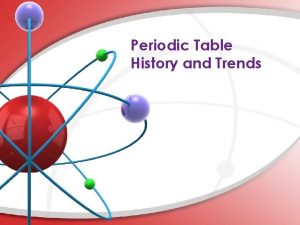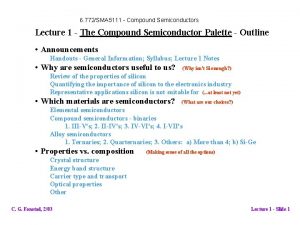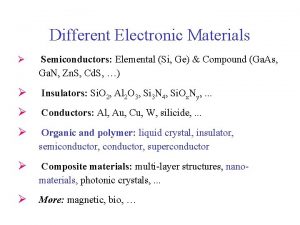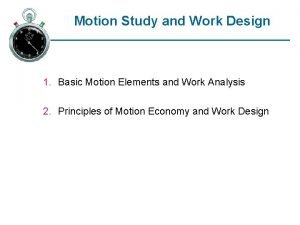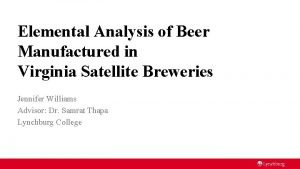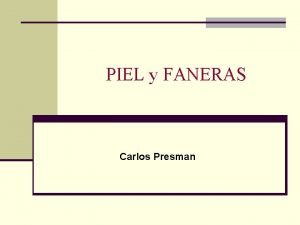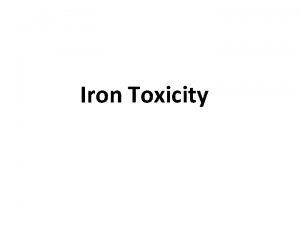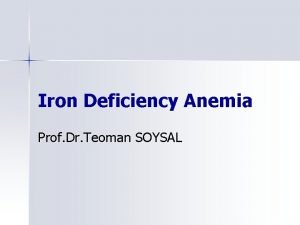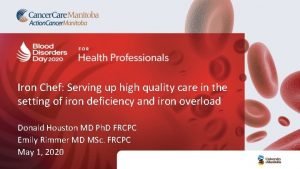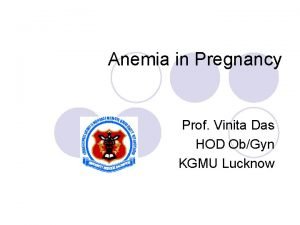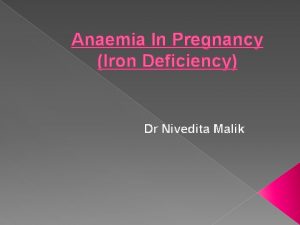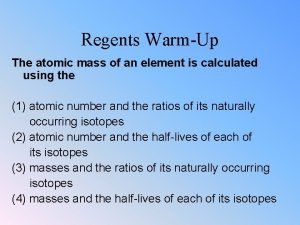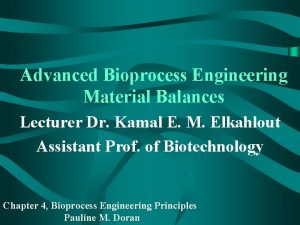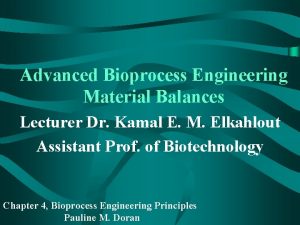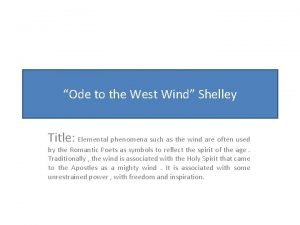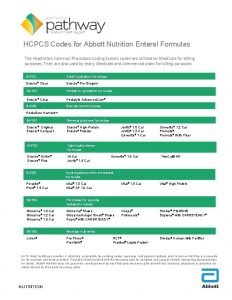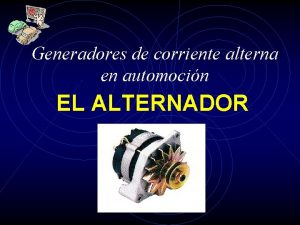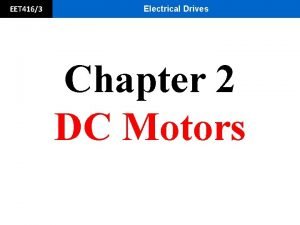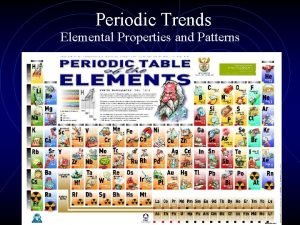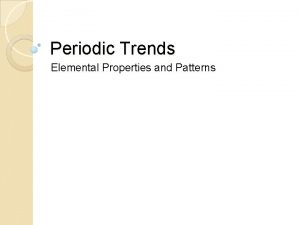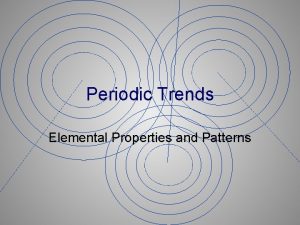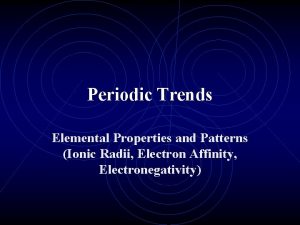Periodic Trends Elemental Properties and Patterns Periodic Trends





























- Slides: 29

Periodic Trends Elemental Properties and Patterns

Periodic Trends • There are several important atomic characteristics that show predictable trends that you should know. • The first and most important is atomic radius. • Radius is the distance from the center of the nucleus to the “edge” of the electron cloud.

Atomic Radius • Since a cloud’s edge is difficult to define, scientists use define covalent radius, or half the distance between the nuclei of 2 bonded atoms. • Atomic radii are usually measured in picometers (pm) or angstroms (Å). An angstrom is 1 x 10 -10 m.

Covalent Radius • Two Br atoms bonded together are 2. 86 angstroms apart. So, the radius of each atom is 1. 43 Å. 2. 86 Å 1. 43 Å

Atomic Radius • The trend for atomic radius in a vertical column is to go from smaller at the top to larger at the bottom of the family. • Why? • With each step down the family, we add an entirely new energy level to the electron cloud, making the atoms larger with each step.

Atomic Radius • The trend across a horizontal period is less obvious. • What happens to atomic structure as we step from left to right? • Each step adds a proton and an electron (and 1 or 2 neutrons). • Electrons are added to existing energy levels or sublevels.

Atomic Radius • The effect is that the more positive nucleus has a greater pull on the electron cloud. • The nucleus is more positive and the electron cloud is more negative. • The increased attraction pulls the cloud in, making atoms smaller as we move from left to right across a period.

Effective Nuclear Charge • What keeps electrons from simply flying off into space? • Effective nuclear charge is the pull that an electron “feels” from the nucleus. • The closer an electron is to the nucleus, the more pull it feels. • As effective nuclear charge increases, the electron cloud is pulled in tighter.

Atomic Radius • The overall trend in atomic radius looks like this.

Atomic Radius • Here is an animation to explain the trend. • On your help sheet, draw arrows like this:

Shielding • As more energy levels are added to atoms, the inner layers of electrons shield the outer electrons from the nucleus. • The effective nuclear charge (enc) on those outer electrons is less, and so the outer electrons are less tightly held.

Ionization Energy • This is the second important periodic trend. • If an electron is given enough energy (in the form of a photon) to overcome the effective nuclear charge holding the electron in the cloud, it can leave the atom completely. • The atom has been “ionized” or charged. • The number of protons and electrons is no longer equal.

Ionization Energy • The energy required to remove an electron from an atom is ionization energy. (measured in kilojoules, k. J) • The larger the atom is, the easier its electrons are to remove. • Ionization energy and atomic radius are inversely proportional. • Ionization energy is always endothermic, that is energy is added to the atom to remove the electron.

Ionization Energy

Ionization Energy (Potential) • Draw arrows on your help sheet like this:

Electron Affinity • What does the word ‘affinity’ mean? • Electron affinity is the energy change that occurs when an atom gains an electron (also measured in k. J). • Where ionization energy is always endothermic, electron affinity is usually exothermic, but not always.

Electron Affinity • Electron affinity is exothermic if there is an empty or partially empty orbital for an electron to occupy. • If there are no empty spaces, a new orbital or energy level must be created, making the process endothermic. • This is true for the alkaline earth metals and the noble gases.

Electron Affinity • Your help sheet should look like this: + +

Metallic Character • This is simply a relative measure of how easily atoms lose or give up electrons. • Your help sheet should look like this:

Electronegativity • Electronegativity is a measure of an atom’s • • • attraction for another atom’s electrons. It is an arbitrary scale that ranges from 0 to 4. The units of electronegativity are Paulings. Generally, metals are electron givers and have low electronegativities. Nonmetals are electron takers and have high electronegativities. What about the noble gases?

Electronegativity • Your help sheet should look like this: 0

Overall Reactivity • This ties all the previous trends together in one package. • However, we must treat metals and nonmetals separately. • The most reactive metals are the largest since they are the best electron givers. • The most reactive nonmetals are the smallest ones, the best electron takers.

Overall Reactivity • Your help sheet will look like this: 0

The Octet Rule • The “goal” of most atoms (except H, Li and Be) is to have an octet or group of 8 electrons in their valence energy level. • They may accomplish this by either giving electrons away or taking them. • Metals generally give electrons, nonmetals take them from other atoms. • Atoms that have gained or lost electrons are called ions.

Ions • When an atom gains an electron, it becomes negatively charged (more electrons than protons ) and is called an anion. • In the same way that nonmetal atoms can gain electrons, metal atoms can lose electrons. • They become positively charged cations.

Ions • Here is a simple way to remember which is the cation and which the anion: + + This is Ann Ion. This is a cat-ion. She’s unhappy and negative. He’s a “plussy” cat!

Ionic Radius • Cations are always smaller than the original atom. • The entire outer energy level is removed during ionization. • Conversely, anions are always larger than the original atom. • Electrons are added to the outer energy level.

Cation Formation Effective nuclear charge on remaining electrons increases. Na atom 1 valence electron 11 p+ Valence elost in ion formation Result: a smaller sodium cation, Na+ Remaining e- are pulled in closer to the nucleus. Ionic size decreases.

Anion Formation Chlorine atom with 7 valence e 17 p+ One e- is added to the outer shell. Effective nuclear charge is reduced and the e- cloud expands. A chloride ion is produced. It is larger than the original atom.
 Periodic trends in elemental properties
Periodic trends in elemental properties Periodic trends in elemental properties
Periodic trends in elemental properties Periodic trends in elemental properties
Periodic trends in elemental properties Periodic trend
Periodic trend Periodic trends in properties of elements
Periodic trends in properties of elements How to find out group and period of an element
How to find out group and period of an element Quarternaries
Quarternaries Elemental and compound semiconductors
Elemental and compound semiconductors A visual aid used to show statistical trends and patterns
A visual aid used to show statistical trends and patterns A visual aid used to show statistical trends and patterns.
A visual aid used to show statistical trends and patterns. X videos
X videos Therblig
Therblig Elemental analysis of beer
Elemental analysis of beer Unidad elemental
Unidad elemental Dermatoficias
Dermatoficias Elemental iron dose
Elemental iron dose Lenfadenomegali
Lenfadenomegali Elemental iron dose
Elemental iron dose Elemental enteral nutrition
Elemental enteral nutrition Características
Características Dashod dog
Dashod dog Elemental iron dose
Elemental iron dose Elemental state
Elemental state Que es la gimnasia elemental
Que es la gimnasia elemental Elemental balance in bioprocess
Elemental balance in bioprocess Steady state vs equilibrium
Steady state vs equilibrium Ode to the elemental rainbow
Ode to the elemental rainbow Abbott enteral formulas
Abbott enteral formulas Masas polares alternador
Masas polares alternador Flemings left hand rule
Flemings left hand rule




